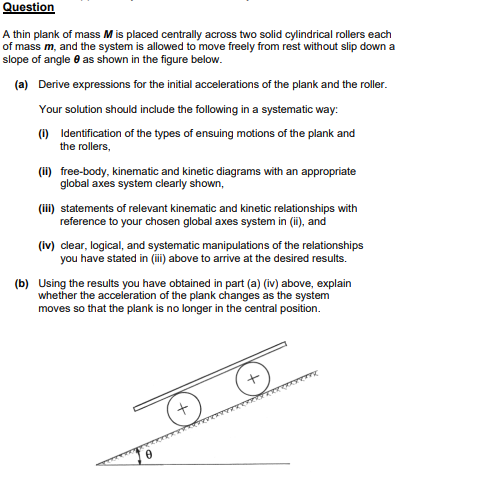plank laced cent across two solid cylindrical rollers each of mass m, and the system is allowed to move freely from rest without slip down a slope of angle as shown in the figure below. (a) Derive expressions for the initial accelerations of the plank and the roller. Your solution should include the following in a systematic way: (1) Identification of the types of ensuing motions of the plank and the rollers, (ii) free-body, kinematic and kinetic diagrams with an appropriate global axes system clearly shown, (iii) statements of relevant kinematic and kinetic relationships with reference to your chosen global axes system in (ii), and (iv) clear, logical, and systematic manipulations of the relationships you have stated in (iii) above to arrive at the desired results. (b) Using the results you have obtained in part (a) (iv) above, explain whether the acceleration of the plank changes as the system moves so that the plank is no longer in the central position.
plank laced cent across two solid cylindrical rollers each of mass m, and the system is allowed to move freely from rest without slip down a slope of angle as shown in the figure below. (a) Derive expressions for the initial accelerations of the plank and the roller. Your solution should include the following in a systematic way: (1) Identification of the types of ensuing motions of the plank and the rollers, (ii) free-body, kinematic and kinetic diagrams with an appropriate global axes system clearly shown, (iii) statements of relevant kinematic and kinetic relationships with reference to your chosen global axes system in (ii), and (iv) clear, logical, and systematic manipulations of the relationships you have stated in (iii) above to arrive at the desired results. (b) Using the results you have obtained in part (a) (iv) above, explain whether the acceleration of the plank changes as the system moves so that the plank is no longer in the central position.
Elements Of Electromagnetics
7th Edition
ISBN:9780190698614
Author:Sadiku, Matthew N. O.
Publisher:Sadiku, Matthew N. O.
ChapterMA: Math Assessment
Section: Chapter Questions
Problem 1.1MA
Related questions
Question

Transcribed Image Text:Question
A thin plank of mass M is placed centrally across two solid cylindrical rollers each
of mass m, and the system is allowed to move freely from rest without slip down a
slope of angle as shown in the figure below.
(a) Derive expressions for the initial accelerations of the plank and the roller.
Your solution should include the following in a systematic way:
(1) Identification of the types of ensuing motions of the plank and
the rollers,
(ii) free-body, kinematic and kinetic diagrams with an appropriate
global axes system clearly shown,
(iii) statements of relevant kinematic and kinetic relationships with
reference to your chosen global axes system in (ii), and
(iv) clear, logical, and systematic manipulations of the relationships
you have stated in (iii) above to arrive at the desired results.
(b) Using the results you have obtained in part (a) (iv) above, explain
whether the acceleration of the plank changes as the system
moves so that the plank is no longer in the central position.
+
Keny
Expert Solution
This question has been solved!
Explore an expertly crafted, step-by-step solution for a thorough understanding of key concepts.
This is a popular solution!
Trending now
This is a popular solution!
Step by step
Solved in 4 steps

Follow-up Questions
Read through expert solutions to related follow-up questions below.
Follow-up Question
Would the plank and the roller have the same acceleration why or why not?
Solution
Knowledge Booster
Learn more about
Need a deep-dive on the concept behind this application? Look no further. Learn more about this topic, mechanical-engineering and related others by exploring similar questions and additional content below.Recommended textbooks for you

Elements Of Electromagnetics
Mechanical Engineering
ISBN:
9780190698614
Author:
Sadiku, Matthew N. O.
Publisher:
Oxford University Press

Mechanics of Materials (10th Edition)
Mechanical Engineering
ISBN:
9780134319650
Author:
Russell C. Hibbeler
Publisher:
PEARSON

Thermodynamics: An Engineering Approach
Mechanical Engineering
ISBN:
9781259822674
Author:
Yunus A. Cengel Dr., Michael A. Boles
Publisher:
McGraw-Hill Education

Elements Of Electromagnetics
Mechanical Engineering
ISBN:
9780190698614
Author:
Sadiku, Matthew N. O.
Publisher:
Oxford University Press

Mechanics of Materials (10th Edition)
Mechanical Engineering
ISBN:
9780134319650
Author:
Russell C. Hibbeler
Publisher:
PEARSON

Thermodynamics: An Engineering Approach
Mechanical Engineering
ISBN:
9781259822674
Author:
Yunus A. Cengel Dr., Michael A. Boles
Publisher:
McGraw-Hill Education

Control Systems Engineering
Mechanical Engineering
ISBN:
9781118170519
Author:
Norman S. Nise
Publisher:
WILEY

Mechanics of Materials (MindTap Course List)
Mechanical Engineering
ISBN:
9781337093347
Author:
Barry J. Goodno, James M. Gere
Publisher:
Cengage Learning

Engineering Mechanics: Statics
Mechanical Engineering
ISBN:
9781118807330
Author:
James L. Meriam, L. G. Kraige, J. N. Bolton
Publisher:
WILEY